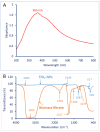An Eco-Friendly Approach Utilizing Green Synthesized Titanium Dioxide Nanoparticles for Leather Conservation against a Fungal Strain, Penicillium expansum AL1, Involved in the Biodeterioration of a Historical Manuscript
- PMID: 37508454
- PMCID: PMC10376199
- DOI: 10.3390/biology12071025
An Eco-Friendly Approach Utilizing Green Synthesized Titanium Dioxide Nanoparticles for Leather Conservation against a Fungal Strain, Penicillium expansum AL1, Involved in the Biodeterioration of a Historical Manuscript
Abstract
The main hypothesis of the present research is investigating the efficacy of titanium oxide nanoparticles (TiO2-NPs) to prevent the growth of fungal strains when applied on leather under an experimental study. Therefore, fifteen fungal strains were isolated from a deteriorated historical manuscript (papers and leathers) and identified by traditional methods and ITS sequence analysis, including Aspergillus chevalieri (one isolate), A. nidulans (two strains), A. flavus (four strains), A. cristatus (one strain), A. niger (one strain), Paecilomyces fulvus (two strains), Penicillium expansum (two strains), and P. citrinum (two strains). The enzymes cellulase, amylase, pectinase, and gelatinase, which play a crucial role in biodegradation, were highly active in these fungal strains. TiO2-NPs were formed using the cell-free filtrate of the probiotic bacterial strain, Lactobacillus plantarum, and characterized. Data showed that the TiO2-NPs were successfully formed with a spherical shape and anatase phase with sizes of 2-8 nm. Moreover, the EDX analysis revealed that the Ti and O ions occupied the main component with weight percentages of 41.66 and 31.76%, respectively. The in vitro cytotoxicity of TiO2-NPs toward two normal cell lines, WI38 and HFB4, showed a low toxicity effect against normal cells (IC50 = 114.1 ± 8.1µg mL-1 for Wi38, and 237.5 ± 3.5µg mL-1 for HFB4). Therefore, concentrations of 100 μg mL-1 were used to load on prepared leather samples before inoculation with fungal strain P. expansum AL1. The experimental study revealed that the loaded TiO2-NPs have the efficacy to inhibit fungal growth with percentages of 73.2 ± 2.5%, 84.2 ± 1.8%, and 88.8 ± 0.6% after 7, 14, and 21 days, respectively. Also, the analyses including SEM, FTIR-ART, color change, and mechanical properties for leather inoculated with fungal strain AL1 in the absence of NPs showed high damage aspects compared to those inoculated with fungal strains in the presence of TiO2-NPs.
Keywords: biodeterioration; biological control; fungi; green synthesis; probiotic bacteria; titanium dioxide nanoparticles.
Conflict of interest statement
The authors declare no conflict of interest.
Figures









References
-
- Hassan R.R.A., Mahmoud S.M.A., Nessem M.A., Aty R.T.A., Ramzy M.G., Dessoky E.S., Abdelkhalek A., Salem M.Z. Hydroxypropyl cellulose loaded with ZnO nanoparticles for enhancing the mechanical properties of Papyrus (Cyperus papyrus L.) Strips. BioResources. 2021;16:2607–2625. doi: 10.15376/biores.16.2.2607-2625. - DOI
-
- Anbumani D., Dhandapani K.v., Manoharan J., Babujanarthanam R., Bashir A.K.H., Muthusamy K., Alfarhan A., Kanimozhi K. Green synthesis and antimicrobial efficacy of titanium dioxide nanoparticles using Luffa acutangula leaf extract. J. King Saud Univ. Sci. 2022;34:101896. doi: 10.1016/j.jksus.2022.101896. - DOI
-
- Kirthi A.V., Rahuman A.A., Rajakumar G., Marimuthu S., Santhoshkumar T., Jayaseelan C., Elango G., Zahir A.A., Kamaraj C., Bagavan A. Biosynthesis of titanium dioxide nanoparticles using bacterium Bacillus subtilis. Mater. Lett. 2011;65:2745–2747. doi: 10.1016/j.matlet.2011.05.077. - DOI
LinkOut - more resources
Full Text Sources

